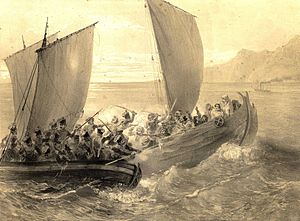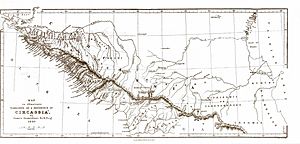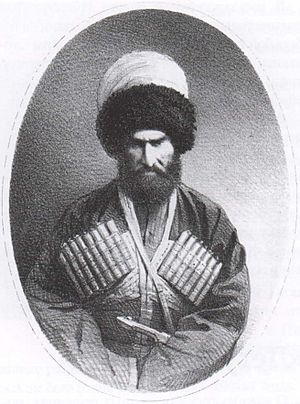Azov Cossack Host facts for kids
The Azov Cossack Host was a special group of Cossacks who lived on the northern coast of the Sea of Azov. They existed from 1832 to 1862. These Cossacks were unique because their main job was to guard the coast by sea. They played a big part in the Caucasus War and the Crimean War.
Most of the Azov Cossacks were originally from the Danubian Sich. They had lived in exile in the Ottoman Empire but returned to Russia in 1828.
Contents
Why the Azov Cossacks Formed
During the Russo-Turkish War (1828–1829), some Danubian Sich Cossacks, led by their leader Osip Gladky, decided to join Russia. They had left Russia in 1775 but were pardoned by Tsar Nicholas I in 1828. The Tsar formed a "Special Zaporozhian Host" from them, and they fought bravely in the war.
After Russia won the war, the Tsar wanted these Cossacks to move to the Kuban region. This was so they could join other Cossacks fighting in the Caucasus War. However, Osip Gladky felt it would be too hard for his small group to move so far. He also didn't want to be under the command of the other Cossack leaders there.
So, the Tsar allowed them to find an empty land closer to where they were. Gladky found a suitable area on the northern coast of the Azov Sea, between Berdyansk and Mariupol.
In 1832, Gladky moved his group, which included about 2,336 Cossacks, to this new land. This is when the Azov Cossack Host was officially created. Osip Gladky became their appointed leader, called an Ataman. They were the only Cossack group whose main duty was to patrol the Black Sea and Azov Sea coasts. To make their group bigger, peasants from a nearby village and volunteers from other regions joined them. Later, in 1839, a group of 217 Nekrasov Cossacks also became part of the Azov Host.
Guarding the Black Sea Coast
The Azov Host quickly became involved in the Caucasus War. Their job was to patrol the long Black Sea coast, from the Strait of Kerch to Abkhazia. They used special boats called barka to scout the area and support Russian soldiers landing on the difficult coast.
The Azov Cossacks were very good at stopping illegal supplies from reaching the Circassians. In 1835, they even captured an English ship called Vixen that was carrying many illegal rifles.
However, in 1840, a Circassian leader named Magomet-Amin attacked the Black Sea coast. Many Russian forts were taken over. The Azov Cossacks played a crucial role in helping to evacuate the surviving Russian units from these areas.
Even though some forts were lost, the Azov Cossacks continued their important work patrolling the Black Sea Coast. By 1845, they had two main groups patrolling different sections of the coast. Their success made them famous, and people said they "struck fear" into the captains of illegal ships.
The Crimean War and Azov Cossacks
By 1848, it was clear that Russia was heading for another big war, this time against the Ottoman Empire and its allies, Britain and France.
The Azov Cossack Host's first task was to destroy some Russian strongholds they had built on the Caucasus coast. This was to prevent them from falling into enemy hands.
When British and French navies entered the Sea of Azov through the Strait of Kerch, they planned to sail up the Don River. Their goal was to distract Russian armies. The Azov Host, which had about 1,920 men, successfully stopped the enemy from reaching the Don River. This was a major achievement, especially during the Siege of Taganrog.
Besides guarding the Don and their Black Sea duties, the Azov Cossacks also had to protect their own homes. Osip Gladky formed three special units: a naval battalion, an infantry battalion, and a cavalry group.
In May 1855, a large fleet of 57 English and French ships easily took control of the weakly defended Strait of Kerch. They then entered the Azov Sea. Enemy ships attacked cities like Berdyansk, Mariupol, and other coastal towns. However, every time the enemy tried to land troops on the shore, the Azov Cossacks successfully fought them off. For example, when Anglo-French troops tried to land at the Azov Host's headquarters, none of their landing boats reached the shore.
After the war ended in 1856, most of the special units were disbanded. The Azov Host was given a very high award, the Banner of St. George. This banner honored their "exceptional bravery and excellent service" during the war.
The End of the Azov Host
After the Crimean War, Osip Gladky, who had become a General-Colonel, retired in 1866. The northern shore of the Azov Sea, where the Cossacks had lived for 30 years, became a rich area. The Cossacks, numbering about 10,000 men, were involved in fishing, farming, and trading.
However, in 1860, the Caucasus War was nearing its end. Russian General Nikolay Yevdokimov suggested to Emperor Alexander II that the Azov Cossacks should move to the Western Caucasus. Their military role was becoming less important as the Imperial Russian Navy was taking over their coast guard duties.
The plan was to move about 800 Cossack families to the Western Caucasus. They were promised money and free transport. Most of the Azov Cossacks, especially those who were descendants of the Danubian Sich and Nekrasovites, agreed to move to the Kuban region. However, some Cossacks who were originally local peasants and traders chose to stay.
In 1862, nearly half of the Azov Host, about 1,093 families (5,224 people), left the Azov region. They settled in new villages in the Kuban Cossack Host area. They helped fight in the final stages of the Caucasus War, which ended two years later in 1864. After that, the former Azov Cossacks became fully integrated into the Kuban Host. Their descendants still live in the mountainous areas of modern Krasnodar Krai and Adygea in Russia.
The remaining Azov region became part of the Yekaterinoslav Governorate. Today, there are efforts to share the history of the Cossack heritage in the region.
Images for kids







